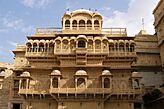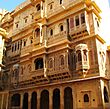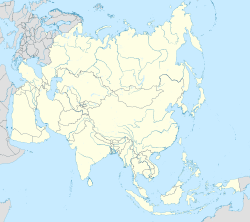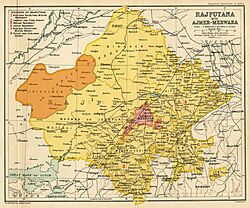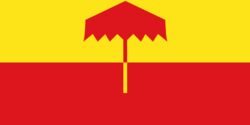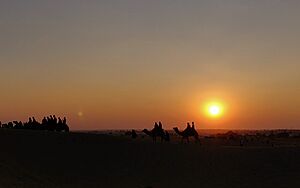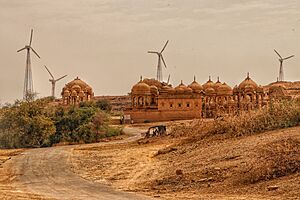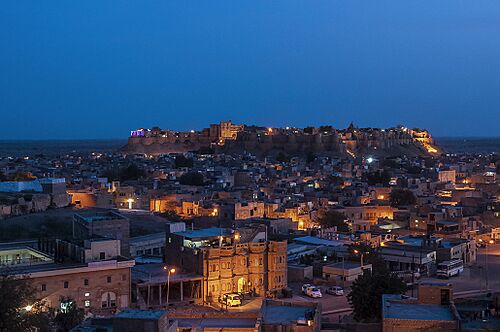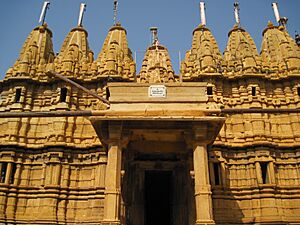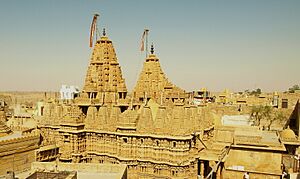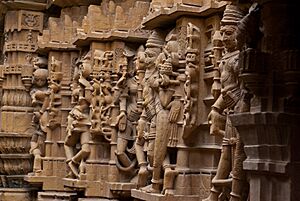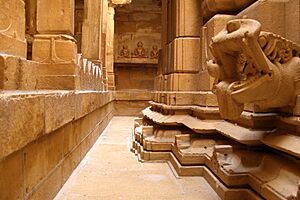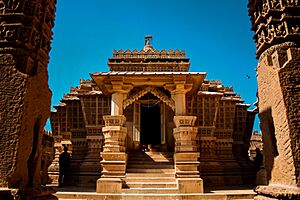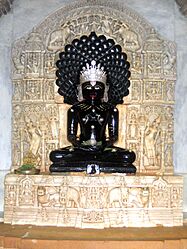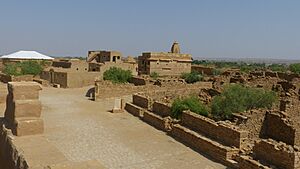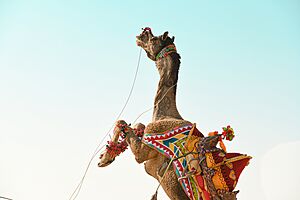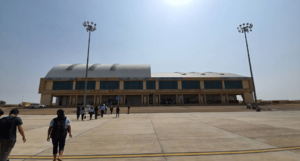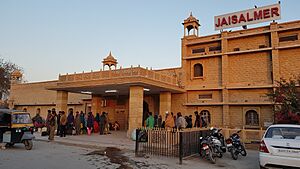Jaisalmer facts for kids
Quick facts for kids
Jaisalmer
|
|
|---|---|
|
City
|
|
|
Jaisalmer Fort
Nathmal's Haveli
Patwa Haveli
Fort Palace
Bada Bagh
Desert Festival
Thar Desert Sand Dunes
Gadisar Lake
|
|
| Nickname(s):
The Golden City, Swarna Nagari
|
|
| Country | |
| State | Rajasthan |
| District | Jaisalmer |
| Established | 1156 |
| Founded by | Rawal Jaisal |
| Named for | Rawal Jaisal |
| Government | |
| • Type | Municipal Council |
| • Body | Jaisalmer Municipal Council |
| Area | |
| • Urban | 62.38 km2 (24.09 sq mi) |
| Elevation | 225 m (738 ft) |
| Population
(2011)
|
|
| • City | 65,471 |
| Languages | |
| • Official | Hindi |
| • Additional official | English |
| • Regional | Marwari, Rajasthani |
| Time zone | UTC+5:30 (IST) |
| PIN |
345 001
|
| Telephone code | 02992 |
| ISO 3166 code | RJ-IN |
| Vehicle registration | RJ-15 |
Jaisalmer, often called "The Golden City", is a city in the Indian state of Rajasthan. It is located about 575 kilometers (357 miles) west of Jaipur, the state capital. Jaisalmer is the main city of the Jaisalmer district.
Before India became independent, Jaisalmer was the capital of the Jaisalmer State. This state was ruled by the Bhati Rajput family. The city is built on a ridge of yellowish sandstone. On top of this ridge stands the ancient Jaisalmer Fort. This fort has a royal palace and beautiful Jain temples. Many houses and temples in the city are also made from this finely carved yellow sandstone.
Jaisalmer is in the middle of the Thar Desert, also known as the Great Indian Desert. The city has a population of about 78,000 people, including those who live inside the fort. Jaisalmer was ranked among the top 10 most welcoming cities in the world by Booking.com, being the only Indian city on that list.
Contents
What's in a Name?
Jaisalmer was founded in 1156 AD by a ruler named Rawal Jaisal. The city is named after him. "Jaisal" comes from the king's name, and "Mer" means a fort. So, Jaisalmer means "The Fort of Jaisal." This name highlights the city's history as a fortified place and its royal past. The word "Mer" or "Meru" comes from an old Indian language called Sanskrit. It means a mountain or a high, important place.
Jaisalmer's Past
Early History
The state of Jaisalmer was started by the Bhati dynasty. Early Bhati rulers controlled a large area, from parts of modern-day Afghanistan and Pakistan to areas in India. Over time, their empire became smaller due to attacks from Central Asia. The Bhati rulers eventually moved towards the south. They settled in the Cholistan desert and Jaisalmer. Rawal Jaisal then founded Jaisalmer as the new capital in 1156.
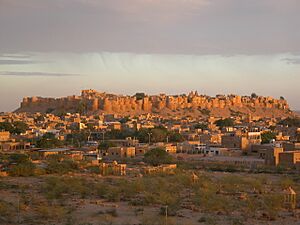
More Recent History
In 1818, Jaisalmer became a British protectorate. This meant it was protected by the British but still had its own ruler.
In the past, the kingdom earned money by taxing caravans that passed through. But when the city of Bombay became a big port, trade routes changed. Ships started carrying goods instead of caravans. This made Jaisalmer's economy much weaker.
The kingdom also faced very bad droughts and famines from 1895 to 1900. This caused many animals, which the kingdom relied on for farming, to die.
After the British left India in 1947, Jaisalmer's ruler, Jawahir Singh, agreed for the state to join the new Union of India. The state kept some control over its own affairs until the 1950s.
Geography and Weather
Jaisalmer is in a dry desert area. This means temperatures can change a lot between day and night, both in summer and winter. In summer, the temperature can reach around 49°C (120°F). In winter, it can drop to about -5°C (23°F). Jaisalmer gets very little rain, averaging about 293.5 millimeters (11.5 inches) per year.
| Climate data for Jaisalmer (1981–2010, extremes 1948–2012) | |||||||||||||
|---|---|---|---|---|---|---|---|---|---|---|---|---|---|
| Month | Jan | Feb | Mar | Apr | May | Jun | Jul | Aug | Sep | Oct | Nov | Dec | Year |
| Record high °C (°F) | 35.8 (96.4) |
37.8 (100.0) |
42.3 (108.1) |
45.8 (114.4) |
50.0 (122.0) |
49.2 (120.6) |
47.0 (116.6) |
43.3 (109.9) |
43.3 (109.9) |
42.2 (108.0) |
38.8 (101.8) |
34.4 (93.9) |
50.0 (122.0) |
| Mean daily maximum °C (°F) | 23.8 (74.8) |
27.3 (81.1) |
33.3 (91.9) |
39.1 (102.4) |
41.9 (107.4) |
40.9 (105.6) |
38.1 (100.6) |
36.6 (97.9) |
37.1 (98.8) |
36.5 (97.7) |
31.3 (88.3) |
25.4 (77.7) |
34.3 (93.7) |
| Mean daily minimum °C (°F) | 7.4 (45.3) |
10.8 (51.4) |
18.1 (64.6) |
21.8 (71.2) |
24.8 (76.6) |
25.8 (78.4) |
25.3 (77.5) |
25.0 (77.0) |
24.2 (75.6) |
19.4 (66.9) |
14.0 (57.2) |
8.8 (47.8) |
18.6 (65.5) |
| Record low °C (°F) | −5.9 (21.4) |
−4.4 (24.1) |
3.4 (38.1) |
10.6 (51.1) |
15.1 (59.2) |
17.2 (63.0) |
20.1 (68.2) |
19.1 (66.4) |
12.9 (55.2) |
8.3 (46.9) |
2.0 (35.6) |
−0.6 (30.9) |
−5.9 (21.4) |
| Average rainfall mm (inches) | 1.3 (0.05) |
5.2 (0.20) |
3.3 (0.13) |
17.2 (0.68) |
27.2 (1.07) |
31.0 (1.22) |
59.2 (2.33) |
72.2 (2.84) |
39.3 (1.55) |
23.0 (0.91) |
13.7 (0.54) |
2.1 (0.08) |
329.6 (12.98) |
| Average rainy days | 0.2 | 0.6 | 0.4 | 0.5 | 2.6 | 3.2 | 4.3 | 4.2 | 2.4 | 1.3 | 0.1 | 0.2 | 19.6 |
| Average relative humidity (%) (at 17:30 IST) | 31 | 26 | 22 | 19 | 21 | 29 | 45 | 50 | 39 | 26 | 27 | 31 | 31 |
| Average dew point °C (°F) | 7 (45) |
10 (50) |
13 (55) |
14 (57) |
17 (63) |
22 (72) |
24 (75) |
24 (75) |
23 (73) |
18 (64) |
13 (55) |
9 (48) |
16 (61) |
| Average ultraviolet index | 5 | 6 | 8 | 8 | 9 | 8 | 8 | 8 | 8 | 7 | 6 | 4 | 7 |
| Source 1: India Meteorological Department Time and Date (dewpoints, 2005–2015) | |||||||||||||
| Source 2: Weather Atlas | |||||||||||||
People of Jaisalmer
| Religions in Jaisalmer City (2011) | ||||
|---|---|---|---|---|
| Religion | Percent | |||
| Hinduism | 89.93% | |||
| Islam | 8.20% | |||
| Sikhism | 0.54% | |||
| Christianity | 0.50% | |||
| Jainism | 0.46% | |||
| Buddhism | 0.07% | |||
In 2011, Jaisalmer had a population of 65,471 people. Most of the people (about 90%) are Hindu. About 8.20% are Muslim, and the rest are Sikhs, Christians, and Jains.
Jaisalmer's Economy
Tourism is a very important part of Jaisalmer's economy. Many people visit to see the fort, desert, and culture.
Recently, Jaisalmer has been focusing on clean energy. Because it's a desert, there's lots of sunlight and wind. This makes it a great place for wind and solar energy projects.
Oil India Limited found natural gas in the Jaisalmer area in 1988. The Indian government had started looking for oil here in 1955–56.
Jaisalmer is also known for its talented musicians and dancers. Manganiyar musicians have performed all over the world. Queen Harish, a famous dancing desert drag queen, has also toured globally and appeared in international movies. The city is also known for its leather messenger bags, made from wild camels.
Culture and City Sights
Jaisalmer Fort
The Jaisalmer Fort was built in 1156 by the Bhati Rajput ruler Jaisal. It is located on Meru Hill and is also called Trikoot Garh. This fort has seen many battles throughout history. Its huge sandstone walls look pale yellow during the day. As the sun sets, they turn a beautiful golden color. This is why Jaisalmer is called "The Golden City."
A famous Indian film director, Satyajit Ray, wrote a detective story and made a movie called Sonar Kella (The Golden Fortress) about this fort. About a quarter of Jaisalmer's population still lives inside the fort. Inside, you can see the Raj Mahal (Royal palace), Jain temples, and the Laxminath temple.
Jain Heritage
Many beautiful buildings in Jaisalmer were built by its Jain community. These include temples, especially those dedicated to the 16th Tirthankara, Shantinath, and the 23rd Tirthankara, Parshvanath.
There are seven Jain temples inside the Jaisalmer fort. They were built between the 12th and 15th centuries. The largest one is the Paraswanath Temple. Other temples include the Chandraprabhu temple, Rishabdev temple, Shitalnath Temple, Kunthunath Temple, and Shantinath Temple. These temples are known for their amazing art and architecture from the medieval era. They are made of yellow sandstone and have very detailed carvings.
Jaisalmer also has some of India's oldest libraries. These libraries hold very rare old writings and items from the Jain tradition. There are many pilgrimage centers (holy places) around Jaisalmer. These include Lodhurva Jain temple (Lodarva), Amarsagar, Brahmsar, and Pokharan.
Other Sights
- Gadisar Lake – This beautiful rainwater lake was dug in 1367 by Rawal Gadsi Singh. It is surrounded by small temples and shrines. In the past, this lake was the main water source for Jaisalmer. However, due to more water being used for farming, the lake is now at risk of drying up.
- Bada Bagh – This is a complex with chhatris (dome-shaped pavilions) built for the rulers of Jaisalmer. It includes the chhatri of Jai Singh II (who died in 1743) and later Maharajas.
In the Area
- Jaisalmer War Museum – This museum honors India's military history and the brave soldiers who made sacrifices.
- Kuldhara – This is a ghost village near Jaisalmer. It was abandoned suddenly centuries ago.
- Tanot Mata – A historical temple located near the border between India and Pakistan.
- Ramdevra – A village in Jaisalmer named after Baba Ramdevji. He was a saint who passed away in 1384 CE. Many groups in India still worship him today.
- Battle of Longewala point – A site important for its historical battle.
- Desert National Park – A large protected area that is home to desert wildlife.
- Lodhruva – An ancient town with historical significance.
- Rajkumari Ratnavati Girls School – A unique school designed to help girls in the region get an education.
Museums to Explore
- Thar Heritage Museum
- Baa RI Haveli On Fort
- Desert Culture Centre & Museum
- Jaisalmer Folklore Museum
- Government Museum
- Jaisalmer Fort Palace Museum
- Akal Fossil Park Museum
- Cactus Park Museum, Kuldhara
- Tanot Museum
Desert Festival
The Desert Festival of Jaisalmer is a very popular and colorful event in Rajasthan. It happens every year in February. During the festival, you can see exciting camel races, turban-tying competitions, and the "Mr. Desert" contest.
The festival also features traditional Rajasthani folk songs and dances. It's a big attraction for tourists from all over the world. The Gair and Fire dancers are a major highlight of the celebrations. This is a great time to visit Jaisalmer to experience amazing performing arts like Kalbelia dances and folk music.
Getting Around
Jaisalmer is connected to other parts of Rajasthan by buses. These buses are run by the Rajasthan State Road Transport Corporation and other private companies.
Jaisalmer Airport is about 17 kilometers (10.5 miles) southeast of the city. You can fly to Jaisalmer from cities like Mumbai, Delhi, Bangalore, Jaipur, Ahmedabad, Surat, and Jodhpur.
Jaisalmer railway station has daily trains that connect Jaisalmer to Jaipur. From Jaipur, you can travel to Delhi and other cities across India. There's also a special luxury tourist train called Palace on Wheels. This train visits major tourist spots in Rajasthan, including Jaisalmer.
Notable People
- Multanaram Barupal – A politician and former member of the Rajasthan Legislative Assembly from Jaisalmer.
- Chhotu Singh Bhati – A politician and current member of the Rajasthan Legislative Assembly from Jaisalmer.
- Queen Harish – A famous folk dancer.
- Malika Jahan – A princess from Jaisalmer who became the wife of the Mughal emperor Jahangir.
- Swaroop Khan – A playback folk singer.
- Raseshwari Rajya Laxmi – A queen of Jaisalmer.
- Rajyavardhan Singh Rathore – A politician, Olympic medalist, and retired colonel in the Indian Army.
- Rooparam – A politician and former member of the Rajasthan Legislative Assembly from Jaisalmer.
- Gajendra Singh Shekhawat – A politician and a union cabinet minister in the Ministry of Jal Shakti.
See also
 In Spanish: Jaisalmer para niños
In Spanish: Jaisalmer para niños



